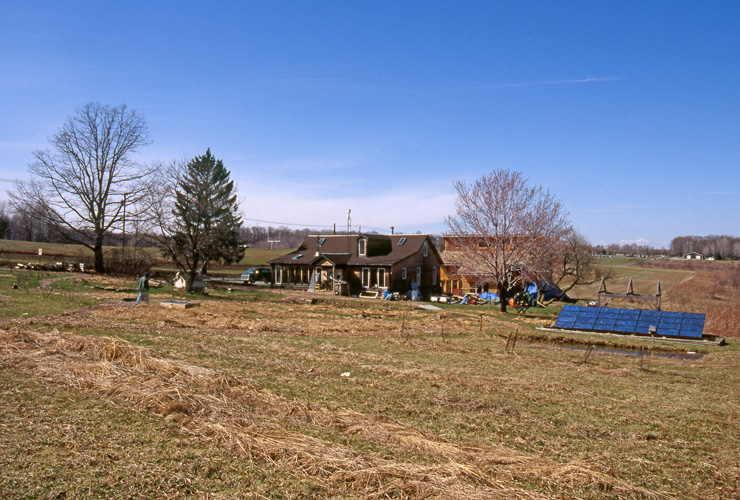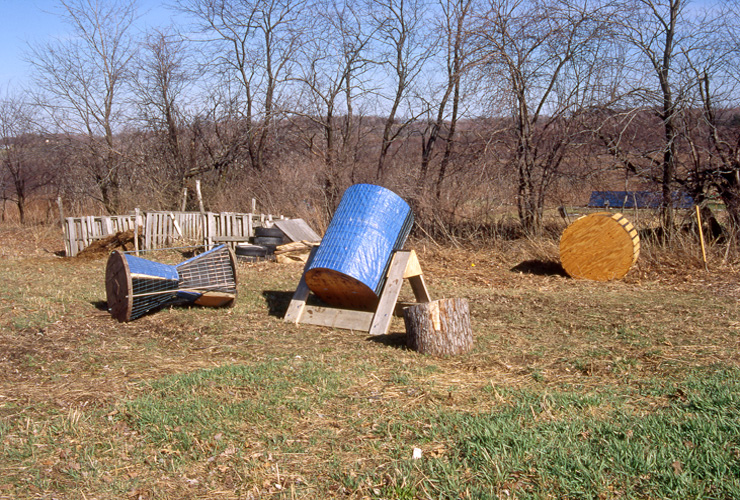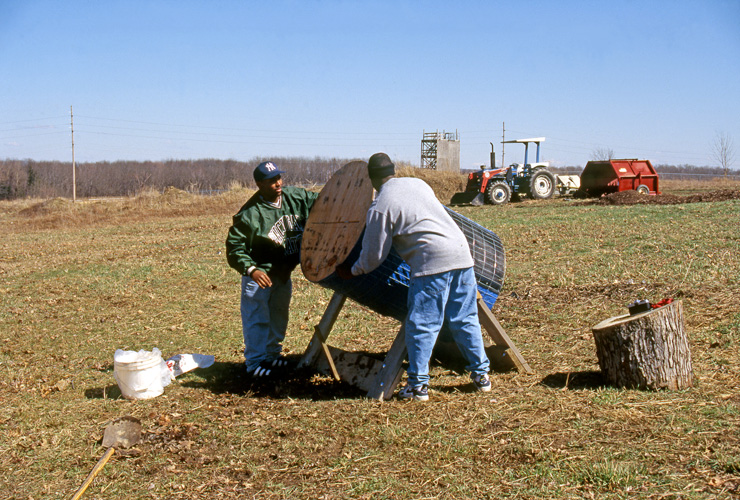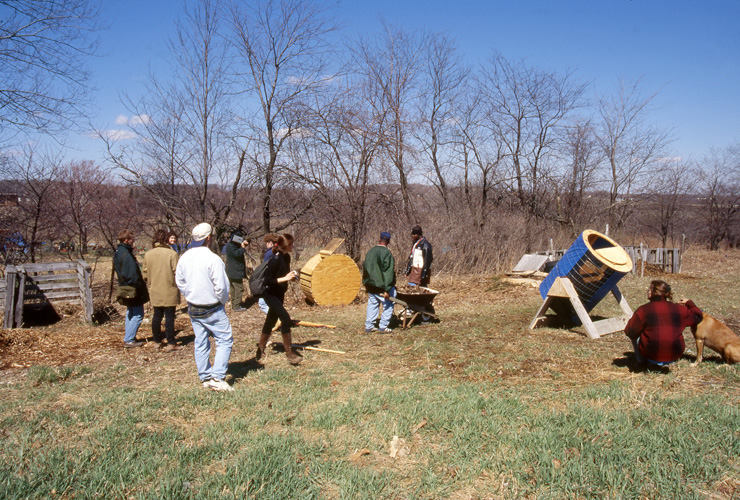Compost Project
Compost Project is project consisting of a workshop with
students and inner city youth investigating compost as a sculptural,
conceptual and ecological medium.
Sponsored by the Manchester Craftsmans Guild, Pittsburg, PA and the
ALTER Project - Research Center for Sustainable Systems, Harmony Homestead, Slippery
Rock University, Slippery Rock, PA, 1996.
(The name of the Center was understood to be The ALTER Project in 1996 and is used for the Compost Project's description below, see bottom for more information on the Center).
Far left: View of the ALTER Project's site and buildings at Harmony Homestead, at the time of the workshop in 1996.
Middle left: Compost structures constructed during workshop, materials:
plywood, wood, window screen, wire fencing, plastic sheet, organic
refuse, 2.5 - 4 ft. diameter.
Middle right: Workshop particpants rotating composting materials in one of the compost structures. The tractor in the background was used for farm-scale composting procedures at the Center.
Far right: Group interaction of composting structures, particpants, ALTER Project staff and university students.
The making of compost is a process of biological decomposition of organic plant materials and their alteration into a rich, soil-like mixture. My interest in this process lies in its relationship to other forms of metabolic and transformative activity. Composting can be seen as a very slow form of fire or a very fast form of the consolidation of coal. This generation of heat and transformation of materiality is also common to the functioning of animal and plant organisms through the degenerative process of catabolism and the regenerative process of anabolism, the two interdependent phases of metabolism. The cycles of carbon exchange, respiration and photosynthesis may also be included in this construct. An additional correlation is to the process of creativity as in art making, where ideas and emotions become form and material with inspiration as the energetic protagonist. Compost and the making of compost can be seen as analogous to life itself; this analogy it at once empirical and poetic, existential and metaphorical.
In April of 1996 I was given the opportunity to interact over the period of a week with students and staff of the Manchester Craftsman Guild of Pittsburg, PA and The ALTER Project at Slippery Rock University in Slippery Rock, PA. We worked together in a collaborative effort to explore the process of composting in the context of art making. Our task was to investigate the conceptual, poetic, practical, social, sculptural and kinetic possibilities of compost making. The workshop’s procedure was to begin with exploratory discussions about composting, we then decided to focus on designing apparatus for the production of compost and broke off into individual conceptual design and model investigations. After a group analysis and critique of the proposals we hybridized designs and formed collaborative teams to build working prototypes of compost devices. |
These were built out of simple materials with an eye to both the aesthetic and kinetic need for composting materials to be housed and rotated as well as to the potential of such a device for revealing insight or relationships with the compost process and other human activity. The completed prototypes were sited on the land of the ALTER Project near a larger farm-scale composting area. The devices were then filled by participants of the workshop with materials brought from Manchester’s kitchen and materials from the site.
It was significant that the participants in the workshop were inner-city high school students and college students from the rural domain of Slippery Rock converging at The ALTER Project, which is an experimental farm for the study of ecological and sustainable living systems. This mixture of diverse partners, fermentation of thought and concentrated effort displayed in this workshop hopefully suggested to the participants new relationships between the systems of creativity, metabolism and social interaction.
Materials used in the construction of the compost mixing devices:
Plywood
Lumber
Plastic window screen
Wire fencing
Commercial plastic garbage can
Linseed oil
John Roloff, 1996 |
Additional information about the Alter Program and Robert A. Macoskey Center for Sustainable Systems Education and Research:
The The Robert A. Macoskey Center for Sustainable Systems Education and Research is an 83-acre facility on the campus of Slippery Rock University that promotes sustainability through demonstration, education and research. The center includes a wind turbine and solar panels, organic community and market gardens, a small woodlot, a composting research and demonstration project, and restoration ecology projects. Harmony House, a multipurpose renovated farmhouse at the Macoskey Center, provides additional space for program activities. It has been redesigned for energy efficiency, and includes a library and student research space.
A history of the center can be found at: http://www.frizvanov.net/MS3.htm
|
|



